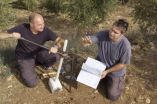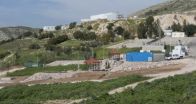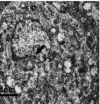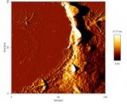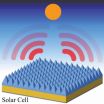(Press-News.org) This news release is available in French.
Tel Aviv/Halle, Saale. The drinking water resources on the eastern, Jordanian side of the Dead Sea could decline severe as a result of climate change than those on the western, Israeli and Palestinian side. This is the conclusion reached by an international team of researchers that calculated the water flows around the Dead Sea. The natural replenishment rate of groundwater will reduce dramatically in the future if precipitation lowers as predicted, say the scientists, writing in the journal Science of the Total Environment. Even now, the available groundwater resources in the region are not sufficient to meet the growing water requirements of the population and agriculture. If the situation worsens, it could therefore have serious social, economic and ecological consequences for the region.
Important data for water providers
A reliable inventory of existing water resources around the Dead Sea, on the border between Israel, Palestine and Jordan, forms the basis for sustainable water management. The lowest lake on earth is not only one of the biggest tourist attractions in the Middle East; more than four million people rely on the groundwater resources in its catchment basin. For a long time, the complex hydrology of this region presented major unknown factors in the local water balance equation. To some extent it still does. Thanks to improved computer simulations, the researchers were able to work out – on an international scale for the first time – how much water actually infiltrates from rainfall and replenishes the groundwater reservoir: around 281 million cubic metres per year. This means that we now also know what the maximum withdrawal limit should be if this resource is to be managed sustainably.
A complicated puzzle with many pieces
Since the 1960s, the majority of the Dead Sea's tributaries have been dammed to capture the precious water before it disappears into the salt lake. However, this apparent salvaging of water is causing the water level of the Dead Sea to fall by around a metre per year and, with it, the surrounding groundwater levels. Fresh water springs thousands of years old are ebbing away. This much was already known. What was not clear was exactly what impact the retreating water levels have on the quantities of usable groundwater. Over the past five years, the team of researchers from Germany, Israel, Jordan and Palestine working on the SUMAR research project therefore used a combination of comprehensive on-site measurements, remote sensing and computer modelling systems to be able to provide a fairly complete answer to this question.
Tracing the course of the water
The springs in and around the Dead Sea were identified using infra-red sensors on aircraft and satellites, as well as chemical and isotopic methods. "By analysing rare earth elements in particular we were able to trace the origin of the water and the routes it takes underground," reports Dr Christian Siebert of the Centre for Environmental Research (UFZ). "Not only were we able to locate 37 areas where groundwater flows into the Dead Sea, we now also know the history of each source. This was important for finding out how much fresh water flows into the Dead Sea underground and is therefore no longer available to use as drinking water. The last passage in particular, before the water from the mountains reaches the lake, took us a long time," says the hydrogeologist. "Here, salt water rising from below mixes with the fresh water, and salt minerals are dissolved in it. But, together with colleagues from the Max Planck Institute in Bremen, we also managed to identify the biogeochemical processes that make permanent changes to the groundwater."
Computer models calculate the total water balance
In the end, all the available data were fed into computer models that revealed, more accurately than ever before, the situation in the drainage basin in the immediate vicinity of the Dead Sea – an area measuring roughly 7000 square kilometres. The biggest challenges were the heterogeneous distribution of urban areas and the associated gaps in the data. Whereas the number of measuring stations in and around built-up areas like Jerusalem and Amman is very high, there are broad stretches of land that are very sparsely populated and therefore have only few wells and almost no geological or meteorological data. Yet rain is particularly important in this context. The region is characterised by short, heavy downpours that often fall over a very small area. For this reason, the project team set up its own measurement stations so as to be able to measure the flash floods that result from these downpours. A comprehensive flow-measuring station was also set up on the River Jordan near one of the baptismal sites that attract thousands of Christian pilgrims every year.
Bleak forecasts
Using the models, the scientists were able, for the first time, to make predictions about possible future changes in the groundwater resources that are so vital for this region: the western (Israeli–Palestinian) side of the lake receives almost twice as much rainfall as the eastern (Jordanian) side. As a result, groundwater replenishment rates are currently around 50 per cent higher on the western side. Climate scenarios predict a decrease in annual rainfall of around 20 per cent. However, the water that currently ends up underground and replenishes these important groundwater resources would be halved. The decrease on the western Israeli–Palestinian side is expected to be around 45 per cent, whereas the water available for the Jordanian (eastern) side would fall by nearly 55 per cent. The social and economic situation could therefore worsen, in Jordan in particular.
Recycling as a way out of the water crisis
Saving and reusing water could therefore be a solution, and the UFZ researchers are developing this concept further with colleagues from Israel, Palestine and Jordan. For instance, the SMART project researched ways of stabilising water supply in the Middle East. The UFZ developed new concepts for decentralised wastewater treatment and made a significant contribution to the water master plan of Jordan, one of the world's most arid countries. Great importance was attached to adapting the wastewater treatment concept to local conditions, and to collaborating with local scientists and authorities. A special implementation office was set up in Jordan's Ministry of Water in Amman.
Ongoing research
Since completion of the SUMAR project, the research has been continued by the Helmholtz centres KIT (Karlsruhe), GFZ (Potsdam), UFZ (Halle) and local partners within the DESERVE (DEad SEa Research VEnue) project. The aim of the meteorologists, hydrogeologists, geologists and geophysicists involved in the project is to look at environmental risks, water availability and climate change as a whole, so as to develop solutions for this unique region, not only so that people will be able to continue to visit the biblical sites, but also so that the people of this region can continue to live there. A stable water supply will therefore play an important role in bringing peace to the Middle East.
Whether the region will ever build the canal intended to carry water from the Red Sea to the Dead Sea remains to be seen. Scientists like Christian Siebert are critical of the possible consequences of importing water in this way: "For instance, it is unclear whether the much lighter ocean water will mix with the Dead Sea water, which is ten times more saline, and we cannot be sure what biological and chemical processes will take place." The impacts on the surrounding groundwater are also disputed.
INFORMATION:
Publication:
Christian Siebert, Tino Rödiger, Ulf Mallast, Agnes Gräbe, Joseph Guttman, Jonathan B. Laronne, Yael Storz-Peretz, Anat Greenman, Elias Salameh, Marwan Al-Raggad, Dina Vachtman, Arie Ben Zvi, Danny Ionescu, Asher Brenner, Ralf Merz, Stefan Geyer (2014): Challenges to estimate surface- and groundwater flow in arid regions: The Dead Sea catchment. Sci Total Environ. Volumes 485-486, 1 July 2014, Pages 828-841
http://dx.doi.org/10.1016/j.scitotenv.2014.04.010
The study was founded by the German Ministry of Education and Research (BMBF) within the IWRM project "Sustainable Management of Water Resources (Quantity and Quality) in the Dead Sea Area (SUMAR)".
For further information please contact:
Dr Christian Siebert/ Dr Tino Rödiger/ Dr Ulf Mallast/ Dipl.- Geogr. Agnes Sachse/ Prof. Dr Ralf Merz/ Dr Stefan Geyer
phone: +49 (0)345-558-5211, -5208, -5210, -5216, -5201, -5217
http://www.ufz.de/index.php?en=16698
http://www.ufz.de/index.php?en=16696
http://www.ufz.de/index.php?en=17552
http://www.ufz.de/index.php?en=17638
http://www.ufz.de/index.php?en=30151
or alternatively:
Tilo Arnhold, Susanne Hufe (UFZ Press Office)
phone: +49 (0)341-235-1635, -1630
http://www.ufz.de/index.php?en=640
Additional Links:
Sustainable Managment of water in semi-arid and Arid Regions (SUMAR)
http://www.ufz.de/index.php?de=30037
Sustainable Management of Available Water Resources with Innovative Technologies (SMART)
http://www.ufz.de/index.php?de=15689
Helmholtz Virtual Institute DEad SEa Research Venue (DESERVE)
http://www.deserve-vi.net/
Integrated project T34: Water Scarcity
http://www.ufz.de/index.php?en=32294
Scientists discover dense and diverse microbial communities in and around fresh water springs on the Dead Sea floor (press release of MPI for Marine Microbiology, 2011):
http://www.mpi-bremen.de/en/Springs_of_Life_in_the_Dead_Sea.html
http://www.plosone.org/article/info%3Adoi%2F10.1371%2Fjournal.pone.0038319
New water balance calculation for the Dead Sea
Climate change could have a bigger impact on water resources in Jordan than in Israel and Palestine
2014-07-22
ELSE PRESS RELEASES FROM THIS DATE:
Novel methods may help stem cells survive transplantation into damaged tissues
2014-07-22
New Rochelle, NY -- Stem cells offer much promise for treating damaged organs and tissues, but with current transplantation approaches stem cell survival is poor, limiting their effectiveness. New methods are being developed and tested to improve the survival and optimize their therapeutic function after transplantation, as described in a Review article in BioResearch Open Access, a peer-reviewed journal from Mary Ann Liebert, Inc., publishers. The article is available free on the BioResearch Open Access website.
In the article 'Preconditioning Stem Cells for In Vivo ...
Study compares cost-effectiveness of weight-loss programs and drugs
2014-07-22
DURHAM, N.C. – In a cost-effectiveness analysis of commercial diet programs and pills, the Weight Watchers program and the drug Qsymia showed the best value for the money. The Jenny Craig regimen generated the greatest weight loss, but was also the most expensive option tested, according to researchers at Duke-National University of Singapore (NUS) Graduate Medical School.
The findings, published in the June issue of the journal Obesity, provide important information on the health and weight-loss benefits per dollar spent as insurance carriers consider coverage for weight ...
The nostalgia effect: Do consumers spend more when thinking about the past?
2014-07-22
Say you are out clothes shopping and you spot something that brings you back to a special time from your childhood when you were surrounded by friends and family. Suddenly, you find yourself purchasing an expensive shirt that makes you feel like a kid again. According to a new study in the Journal of Consumer Research, we're more likely to spend money when we're feeling nostalgic.
"We wondered why nostalgia is so commonplace in marketing. One reason could be that feeling nostalgic weakens a person's desire for money. In other words, someone might be more likely to buy ...
Trying to get kids to eat healthier? Don't tell them veggies are good for them
2014-07-22
At some point, most kids will hear that drinking milk helps make their bones strong or that fish is food for the brain. But do these messages foster the idea that if something is good for us, it must surely taste bad? According to a new study in the Journal of Consumer Research, when children hear about the benefits of healthy food, they're less likely to eat it.
"We predicted that when food is presented to children as making them strong or as a tool to achieve a goal such as learning how to read or count, they would conclude the food is not as tasty and therefore consume ...
You deserve it! Are consumers more likely to buy unique products when made to feel special?
2014-07-22
Graduating from college is an important life event often attributed to being smart and working hard. Many people celebrate this milestone achievement by buying themselves an expensive gift or taking a dream vacation. A new study in the Journal of Consumer Research shows that consumers who attribute their successes to internal character traits rather than hard work are more likely to select unique products.
"We found that consumers who attribute feelings of pride to their unique character traits—rather than how hard they worked to accomplish something—are more likely to ...
HIF 1α viral vector inhibits hippocampal neuronal apoptosis: The future of gene therapy
2014-07-22
Hypoxia-inducible factor 1 (HIF-1) attenuates amyloid-beta protein neurotoxicity and decreases apoptosis induced by oxidative stress or hypoxia in cortical neurons. Prof. Xiqing Chai and co-workers from Hebei Chemical and Pharmaceutical College, China constructed a recombinant adeno-associated virus (rAAV) vector expressing the human HIF-1α gene (rAAV-HIF-1α) efficiently, and tested the assumption that rAAV-HIF-1α represses hippocampal neuronal apoptosis induced by amyloid-beta protein. Their results confirmed that rAAV-HIF-1α significantly reduces apoptosis ...
Acupuncture at the Taixi activates cerebral neurons in old patients with MCI
2014-07-22
Previous findings have demonstrated that acupuncture at the Taixi (KI3) acupoint in healthy youths can activate neurons in cognitive-related cerebral cortex. In a perspective article released in the Neural Regeneration Research (Vol. 9, No. 11, 2014), Dr. Shangjie Chen and co-workers at Baoan Hospital, Southern Medical University, China investigated whether acupuncture at this acupoint in elderly patients with mild cognitive impairment (MCI) can also activate neurons in these regions. Researchers revealed that under resting state and task-related functional magnetic resonance ...
X-ray irradiation at a certain dose alters the neuronal cytoskeleton and cytomechanics
2014-07-22
Cranial radiotherapy is one of the most important therapeutic methods for the treatment of various types of primary and metastatic brain tumors. Although conventional photon irradiation has significantly improved the treatment of cancer, the central nervous system is prone to damage after high-dose irradiation, resulting in severe delayed or progressive nervous tissue injury. The issues regarding brain radiation injury have been widely discussed, and recent investigations have emphasized changes in pathomorphology. However, the underlying mechanism remains in debate. Researchers ...
Self-cooling solar cells boost power, last longer
2014-07-22
WASHINGTON, July 22, 2014—Scientists may have overcome one of the major hurdles in developing high-efficiency, long-lasting solar cells—keeping them cool, even in the blistering heat of the noonday Sun.
By adding a specially patterned layer of silica glass to the surface of ordinary solar cells, a team of researchers led by Shanhui Fan, an electrical engineering professor at Stanford University in California has found a way to let solar cells cool themselves by shepherding away unwanted thermal radiation. The researchers describe their innovative design in the premiere ...
Major dopamine system helps restore consciousness after general anesthesia, study finds
2014-07-22
Chicago – July 22, 2014 – Researchers may be one step closer to better understanding how anesthesia works. A study in the August issue of Anesthesiology, the official medical journal of the American Society of Anesthesiologists® (ASA®), found stimulating a major dopamine-producing region in the brain, the ventral tegmental area (VTA), caused rats to wake from general anesthesia, suggesting that this region plays a key role in restoring consciousness after general anesthesia. Activating this region at the end of surgery could provide a novel approach to proactively induce ...
LAST 30 PRESS RELEASES:
Heart-brain connection: international study reveals the role of the vagus nerve in keeping the heart young
Researchers identify Rb1 as a predictive biomarker for a new therapeutic strategy in some breast cancers
Survey reveals ethical gaps slowing AI adoption in pediatric surgery
Stimulant ADHD medications work differently than thought
AI overestimates how smart people are, according to HSE economists
HSE researchers create genome-wide map of quadruplexes
Scientists boost cell "powerhouses" to burn more calories
Automatic label checking: The missing step in making reliable medical AI
Low daily alcohol intake linked to 50% heightened mouth cancer risk in India
American Meteorological Society announces Rick Spinrad as 2026 President-Elect
Biomass-based carbon capture spotlighted in newly released global climate webinar recording
Illuminating invisible nano pollutants: advanced bioimaging tracks the full journey of emerging nanoscale contaminants in living systems
How does age affect recovery from spinal cord injury?
Novel AI tool offers prognosis for patients with head and neck cancer
Fathers’ microplastic exposure tied to their children’s metabolic problems
Research validates laboratory model for studying high-grade serous ovarian cancer
SIR 2026 delivers transformative breakthroughs in minimally invasive medicine to improve patient care
Stem Cell Reports most downloaded papers of 2025 highlight the breadth and impact of stem cell research
Oxford-led study estimates NHS spends around 3% of its primary and secondary care budget on the health impacts of heat and cold in England
A researcher’s long quest leads to a smart composite breakthrough
Urban wild bees act as “microbial sensors” of city health.
New study finds where you live affects recovery after a hip fracture
Forecasting the impact of fully automated vehicle adoption on US road traffic injuries
Alcohol-related hospitalizations from 2016 to 2022
Semaglutide and hospitalizations in patients with obesity and established cardiovascular disease
Researchers ‘listen in’ to embryo-mother interactions during implantation using a culture system replicating the womb lining
How changing your diet could help save the world
How to make AI truly scalable and reliable for real-time traffic assignment?
Beyond fragmented markets: A new framework for efficient and stable ride-pooling
Can shape priors make road perception more reliable for autonomous driving?
[Press-News.org] New water balance calculation for the Dead SeaClimate change could have a bigger impact on water resources in Jordan than in Israel and Palestine

